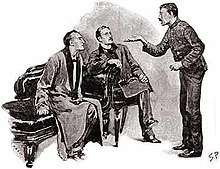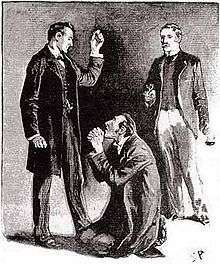The Adventure of the Blue Carbuncle
| "The Adventure of the Blue Carbuncle" | |
|---|---|
 1892 illustration by Sidney Paget | |
| Author | Sir Arthur Conan Doyle |
| Country | United Kingdom |
| Series | The Adventures of Sherlock Holmes |
| Publication date | 1892 |
"The Adventure of the Blue Carbuncle" is one of 56 short Sherlock Holmes stories written by British author Sir Arthur Conan Doyle, the seventh story of twelve in the collection The Adventures of Sherlock Holmes. It was first published in Strand Magazine in January 1892.[1]
Plot summary
As London prepares for Christmas, newspapers report the theft of the near priceless jewel, the "Blue Carbuncle", from the hotel suite of the Countess of Morcar. John Horner, a plumber and a previously convicted felon, is soon arrested for the theft. Though the police have yet to find the jewel, and despite Horner's claims of innocence, the police are sure that they have the thief. Horner's record, and his presence in the Countess's room where he was repairing a fireplace, are all the police need.
Just after Christmas, Watson pays a visit to Holmes at 221b Baker Street. He finds the detective contemplating a battered old hat, one brought to him by the commissionaire Peterson. Both the hat and a Christmas goose had been dropped by a man in a scuffle with some street ruffians. Peterson, an honest man, had hoped for Holmes' help in returning the items to their owner but although the goose bears a tag with the owner's name—Henry Baker—Holmes had little hope of finding the man. Peterson took the goose home for dinner and Holmes kept the hat, to study as an intellectual exercise.
While Watson is there, Peterson returns excited, carrying the Blue Carbuncle, claiming that the carbuncle was found in the found goose's crop (the fact that geese do not have a crop has been regarded by some as Arthur Conan Doyle's greatest blunder[2]). Realizing that the identity of Henry Baker is now part of a larger mystery, Holmes makes a concerted effort to identify him. Based on his observations of the hat and its condition, Holmes makes several deductions as to Baker's age, social standing, intellect and domestic status, but cannot determine if Baker knew that he was carrying a priceless gem. When Baker appears at Baker Street in response to advertisements Holmes had placed in London newspapers, Holmes' deductions prove correct. Holmes gives Baker a new goose, explaining that the old one had been consumed. Baker, happily accepting the replacement bird, declines to cart away his original bird's entrails (Disjecta membra), convincing Holmes that he knew nothing about the missing jewel. Baker does, however, give Holmes the valuable information that he had purchased the goose at the Alpha Inn, a pub near the British Museum.
Holmes and Watson set out across the city to determine how the jewel travelled from the room of the Countess of Morcar to a goose's crop. The proprietor of the Alpha Inn informs them that the goose was purchased from a dealer in Covent Garden. At Covent Garden, a salesman named Breckinridge gets angry with Holmes and refuses to help. The merchant complains of the pestering he has endured about geese sold recently to the landlord of the Alpha Inn. Holmes, realizing that he is not the only one aware of the carbuncle's connection to the goose, tricks an irate Breckinridge into revealing that the bird was supplied by a Mrs Oakshott, a poultry and egg purveyor in Brixton.

A trip to Brixton proves unnecessary when Breckinridge's other "pesterer" appears (a cringing little man named James Ryder, head attendant at the hotel where the carbuncle was stolen), again pressuring Breckinridge to tell him the whereabouts of the Oakshott geese. Holmes and Watson invite Ryder back to Baker Street, telling Ryder that they know he is looking for a goose with a black bar on its tail.
Holmes tells Ryder that the goose "laid an egg after it was dead". Ryder is terrified when he realises that Holmes will turn him over to the police. Pressured by Holmes, Ryder recounts that he and his accomplice Catherine Cusack, the Countess's maid, contrived to frame Horner, knowing that Horner's past would make him an easy scapegoat. But he was plagued by fears of arrest after stealing the stone. During a visit to his sister — Mrs. Oakshott — Ryder hit on the idea of hiding the jewel by feeding it to one of the geese being bred by his sister, one of which had been promised to him as a gift. Unfortunately, Ryder dropped his bird and then confused it with another, taking away the wrong goose. By the time Ryder realised his mistake, the other geese had already been sold. Ryder tried to follow the trail but got no further than Breckinridge.
Being Christmas, Holmes does not have Ryder arrested. He concludes that arresting the clearly anguished Ryder will only make him into a more hardened criminal later. Ryder flees to the continent and Horner will be freed as the case against him will collapse without Ryder's perjured testimony. Holmes remarks that he is not retained by the police to remedy their deficiencies.
Doyle used a similar plot device in the later "Adventure of the Six Napoleons" where a stolen gem was hidden inside one of several plaster busts of Napoleon - but the criminal is not sure which of the busts it was.
Adaptations
An American radio adaptation was aired in 1943, with Basil Rathbone as Holmes and Nigel Bruce as Watson.[3]
There have been three BBC Radio dramatizations:
- 1954, with Sir John Gielgud as Holmes and Sir Ralph Richardson as Watson.[4]
- 29 December 1961, with Carleton Hobbs as Holmes and Norman Shelley as Watson.[5]
- 2 January 1991, adapted by Bert Coules with Clive Merrison as Holmes and Michael Williams as Watson, and featuring Peter Blythe as James Ryder, Ben Onwukwe as John Horner, and Christopher Good as Peterson. [6]
Peter Cushing portrayed Sherlock Holmes in the 1968 BBC series. "The Adventure of Blue Carbuncle" is one of only six surviving episodes.[7]
In 1984 the story was the subject of an episode of the Granada TV version directed by David Carson and starring Jeremy Brett.[8]
This story is also available in an altered version, but with the same characters, as part of Jim Weiss' children's CD, Sherlock Holmes for Children.
It was illustrated in a 1993 issue of Boys' Life magazine.
The animated television series Sherlock Holmes in the 22nd Century featured an adaptation of the story, replacing the goose with a blue stuffed toy called "Carbuncle" and the stone with a microprocessor.[9]
The story was adapted for comics in 2010's Graphic Classics volume 19.
The Swedish augmented reality app StoryTourist plotted the story onto a tour of London in 2018[10].
References
- ↑ "The Blue Carbuncle". Sherlockian.net. Retrieved 2018-01-28.
- ↑ Alfred Hickling. "Review: The New Annotated Sherlock Holmes edited by Leslie S Klinger | Books". The Guardian. Retrieved 2012-07-26.
- ↑ Eyles, Alan (1986). Sherlock Holmes: A Centenary Celebration. Harper & Row. p. 135. ISBN 0-06-015620-1.
- ↑ Eyles, Alan (1986). Sherlock Holmes: A Centenary Celebration. Harper & Row. p. 137. ISBN 0-06-015620-1.
- ↑ DeWaal, Ronald Burt (1974). The World Bibliography of Sherlock Holmes. Bramhall House. p. 388-389. ISBN 0-517-217597.
- ↑ Bert Coules. "The Adventures of Sherlock Holmes". The BBC complete audio Sherlock Holmes. Retrieved 12 December 2016.
- ↑ Stuart Douglas—www.thiswaydown.org. "Missing Episodes". Btinternet.com. Archived from the original on 2012-07-21. Retrieved 2011-05-29.
- ↑ "The Blue Carbuncle". IMDb. Retrieved 2018-01-16.
- ↑ Barnes, Alan (2002). Sherlock Holmes on Screen. Reynolds & Hearn Ltd. p. 165. ISBN 1-903111-04-8.
- ↑ http://www.storytourist.com/press-release
External links


